Photo Redox Reactions
Photo redox reactions are redox reactions, powered by light.
Photosynthesis - A case for two (part 1 of 2)
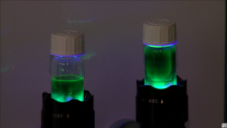
Photosynthesis cannot take place without chlorophyll. Step by step, Prof. Dr. Tausch of the Bergische Universität Wuppertal explains the functions of chlorophyll. The chemical process is illustrated with the Photo-Blue-Bottle experiment. It simulates energy conversion and chemical transformation processes within the complex natural processes of photosynthesis and cellular respiration. Furthermore, the video comprises animations which help visualize the underlying chemical reactions.
Photosynthesis - A case for two (part 2 of 2)
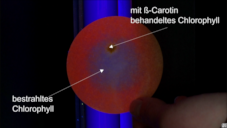
Chlorophyll and beta-carotene complement each other in photosynthesis. In this part of the video, the functions of beta-carotene are discussed. It supports chlorophyll in capturing light, but also protects against too much light. Prof. Dr. Tausch and Rebecca Grandrath of the Bergische Universität Wuppertal explain how this works by availing themselves of lab experiments, models and animated diagrams.
Photo-Blue-Bottle - Electrochemical Concentration Cell
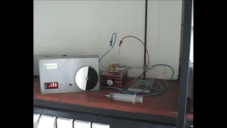
The video shows the Photo-Blue-Bottle experiment in a galvanic cell. Both half cells have the same configuration and contain the same solution. By irradiating one cell with light, a voltage is built up which breaks down again after the introduction of air into the irradiated blue solution. The voltage difference is visualized by a comparator.
Photocatalytic Generation of Hydrogen using the Photo-Blue-Bottle Experiment

The video shows the photoelectrochemical production of hydrogen gas in a two-pot setup. The Photo-Blue-Bottle half cell is irradiated with light of the wavelength 450 nm, so that photochemically driven redox cycles are performed, which lead to the reduction of protons to hydrogen gas in the second half cell. The hydrogen gas is then identified in a modified detonating gas reaction.
Photochemical generation of hydrogen using the PBB-Experiment in a One-Pot-Configuration
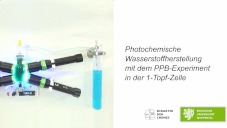
The video shows the photoelectrochemical generation of hydrogen gas in a one-pot setup. For this purpose, a catalyst is added to the photo blue bottle solution and the solution is irradiated with light of wavelength 450 nm. The hydrogen gas is then identified in a modified detonating gas reaction.
Photoelectrochemical reduction of methylene blue
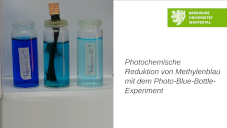
The video shows how methylene blue is electrochemically reduced to leucomethylene blue in one half cell when the other half cell, filled with a photo blue bottle solution, is irradiated. The leucomethylene blue solution is then turned blue again by re-oxidation with atmospheric oxygen.
Photoreforming of ethanol
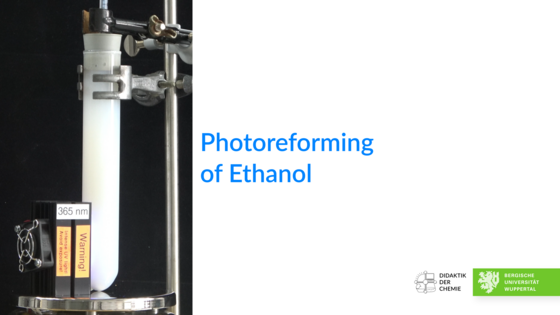
Ethanol is converted to hydrogen and other by-products using a titanium dioxide-based photocatalyst in a simple experimental setup. Afterwards, the oxyhydrogen test is used to prove that the collected gas is hydrogen.
Production of Oxygen using Waterweed
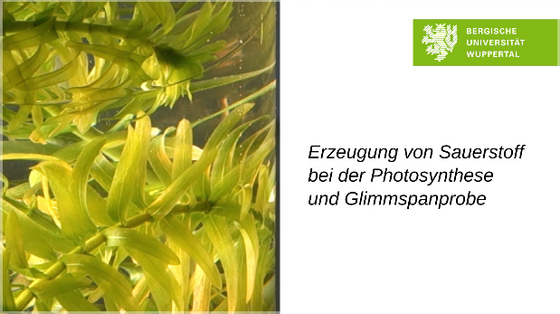
The Video shows the production of oxygen during photosynthesis of waterweed while being irradiated. The produced gas is captured and identified using the glowing splint test.
Detection of Oxygen released by Photosynthesis
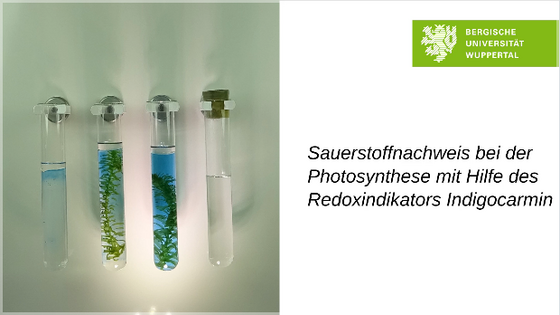
In this video one of the products of photosynthesis, oxygen, is shown using the redox indicator indigocarmine. The produced oxygen causes the solution to turn blue because of reoxidation of the contained indigocarmine species that has been reduced beforehand.
